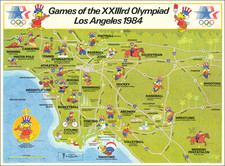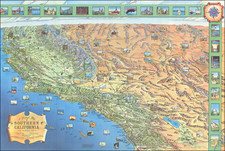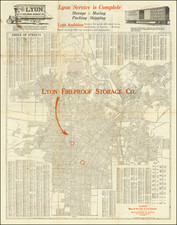Rare Letter Written from the Pueblo de Los Angeles in 1847
Rich Detail on Business Opportunities in California: a List of Goods to Bring to Sell in California
"...you have a slight touch of the California fever..."
A remarkable and richly detailed early letter written from Los Angles by one of its most prominent residents. Francis P. F. Temple here prescribes the medicine for his Massachusetts brother's case of the "California fever." Specifically, Temple provides a detailed list of goods a Yankee trader ought to bring to California:
...blue cotton, blue drilling, bleach'd & unbleached cotton, cassimere broadcloths, muslins, ribbons, boots & shoes, gilt shirt & pantaloon buttons, spool & hank thread, mens & wos. cotton & wosted stockings, two or three medicine chests, percussion caps, cotton & silk hdkfs, cuttery, manufactured & leaf tobaccos, looking glasses, framed pictures & saints, calicos, furniture prints, bedticking, counterframes, shovels, hoes, axes, hatchets, pantaloon & coat stuffs, silk velvet, readymade clothing both woolen & cotton, mens slippers, fancy gown patterns, toys & confectionary would also take well, & lots of other fancy articles which cost but very little there, & would pay a good profit here.
Temple mentions that the letter itself would be taken via the Loo Choo, a storied schooner in California annals, particularly once the Gold Rush got under way.
Schooner Loo Choo
Loo Choo was a 639 ton schooner built in Medford, Massachusetts in 1840. In 1847, Capt. James B. Hatch was commanding the ship in the California Sea Otter trade.
In July 1846, Colonel Jonathan D. Stevenson of New York was asked to raise a volunteer regiment of ten companies of 77 men each to go to California with the understanding that they would muster out and stay in California. They were designated the 1st Regiment of New York Volunteers and took part in the Pacific Coast Campaign. In August and September 1846 the regiment trained and prepared for the trip to California.
Three private merchant ships, Thomas H Perkins, Loo Choo, and Susan Drew, were chartered, and the sloop USS Preble was assigned convoy detail. On September 26 the four ships sailed for California. Fifty men who had been left behind for various reasons sailed on November 13, 1846 on the small storeship USS Brutus. The Susan Drew and Loo Choo reached Valparaíso, Chile by January 20, 1847 and they were on their way again by January 23. The Perkins did not stop until San Francisco, reaching port on March 6, 1847. The Susan Drew arrived on March 20 and the Loo Choo arrived on March 26, 1847, 183 days after leaving New York. The Brutus finally arrived on April 17.
After the discovery of gold in California, numerous ships went into the passenger trade sailing around the tip of South America to San Francisco. Over 100 passengers traveled west aboard Loo Choo in 1849, hoping to strike lucky. She sailed from New York on March 8, 1849 and arrived in San Francisco 139 days later via Cape Horn and Valparaiso, Chile. Loo Choo successfully navigated the treacherous journey around Cape Horn on multiple occasions.
Temple and Workman Families and Early Los Angeles
The Temple-Workman family played a significant role in the early history of Los Angeles and Southern California. Through their involvement in land development and through familial and business connections with other Alta California pioneers, especially Spanish-speaking Californios, the family enjoyed unique influence on the course of the region's early growth.
Jonathan Temple (1796-1866), the first person from either of these two families to settle in Southern California, was sometimes referred to by his Californio moniker Don Juan Temple. A native of Reading, Massachusetts, he lived in San Diego for a short time before establishing an American-style store in Los Angles in 1828. In 1843, he acquired the Rancho Los Cerritos, a 27,000-acre property in the Long Beach area - his 1844 adobe is the centerpiece of the Rancho Los Cerritos historic site. During the 1840s, Temple was active in shipping and commerce along the California and Mexican west coast. Temple was also one of the first real estate developers in L.A., having constructed the original Temple Block and the Market House, which later served as city and county administrative headquarters and the seat of the county courthouse. He would go on to serve as the first alcalde, or mayor of Los Angeles after the town was captured by the United States during the Mexican War.
Francis Pliny Fisk Temple, the younger half-brother of Jonathan Temple, was another prominent early figure in the early development of Southern California. The younger Temple married the daughter of William William, an English-born pioneer who arrived in Los Angeles from Santa Fe via the Old Spanish Trail route in 1841, as part of the Workman-Rowland Party - considered the first overland party of Americans to settle in Los Angeles. Through hard work and business acumen, Workman became one of the city's most successful entrepreneurs. He co-owned a store, served as a judge, and invested in real estate. His son-in-law, Francis Pliny Fisk Temple, also made a name for himself as a landowner and businessman, even branching into banking, and becoming one of the largest landowners in the area.
In summary, the Temple-Workman family were key players in the development of Los Angeles and Southern California during the second have of the 19th century. Their business ventures and land holdings helped shape the city's growth.
The text of the letter here follows:
Pueblo de los Angeles. June 28th 1847
Dear Brother,
The Transport Ship Loo Choo is now laying in the port of San Diego taking in her cargo & within a few days leave for the U.S. by which you will receive these few lines. Yours of Augt. 4th 1846 with those of sister Clarindas & Thorntons came duly at hand a short time after. I had wrote you by the overland route in Feby.
I was happy to hear of your good degree of health and that of the rest of our family & friends.
I observed in your last that you have a slight touch of the California fever, the only remedy is to take a trip out here as I have told you before. I regret that you did not come out ten years ago, when the country was in a flourishing condition, at that time the missions were in their bloom the country covered with immense herds of cattle, money plenty & a few people to do the business, but now it is quite the reverse, the missions are nearly broken down, a very few cattle in comparison with those times, money scarce, and a greater number of people to do the business, even the climate has greatly changed, however it is still a beautiful climate, the most disagreeable time is in the rainy season which is from Nov. to March, more or less after the rains the country looks beautiful for two or three months, and then the vegetation drys up & remains so until the rains of the following season on this account a greater part of the country is unfit for cultivation - those parts which can be irrigated by small rivers & streams are the only parts which can be cultivated.
All this part of the country this side of Monterey is very badly timbered there being none suitable for building short of the mountains which in many places is difficult to get out, on the small rivulets & moist lands there is sufficient wood for domestic use - in the northern part of the country about the bay of San Francisco timber is much more plenty, this part of the country is principally supplied with lumber from there - at the Bodega a small port to the windward of San Francisco there is a steam saw mill ownedby Capt. Smith which is doing a very good business, there are a number of other saw mills in the vicinity of Monterey & San Francisco - lumber is worth from fifty to sixty dollars per M at present. Yerba Buena a town on the bay of San Francisco is growing very fast, it will be by far the biggest town on the coast - the bay of San Franco. is being the depot for a large part of the vessels trading in the Pacific will add much to the value of property in the vicinity.
Should you have an idea of coming out here to settle I should advise you first to come out & see the country you can make the trip out & back in a year and a half and have sufficient time to examine the whole of the coast the profits on the goods you could bring would pay you for your time & expense, & then if that you liked the coast, it would be well, if not you could return without losing your time & expense, I think that you could with certainty count on fifty per cent profit on the cost at home after the freight &c is deducted although the market is fluctuating - there was a New York vessel in Monterey bound to the Columbia, a short time since who sold goods at fifty per cent advance on home prices.
I should think the trip round Cape Horn would be preferable, as if you came across land by Panama you would have to wait there probably a long time for a vessel to come up, and then have to pay nearly as much as the whole passage would have cost by the cape.
If you can make up the sum of five thousand dollars, or make arrangement with someone to go halves with you, & expend them in suitable goods for the market I am confident you could do a good thing out of it - articles that can be stowed as compact as possible would be better (on account of freight as freights are calculated by measurements) such as blue cotton, blue drilling, bleach'd & unbleached cotton, cassimere broadcloths, muslins, ribbons, boots & shoes, gilt shirt & pantaloon buttons, spool & hank thread, mens & wos. cotton & wosted stockings, two or three medicine chests, percussion caps, cotton & silk hdkfs, cuttery, manufactured & leaf tobaccos, looking glasses, framed pictures & saints, calicos, furniture prints, bedticking, counterframes, shovels, hoes, axes, hatchets, pantaloon & coat stuffs, silk velvet, readymade clothing both woolen & cotton, mens slippers, fancy gown patterns, toys & confectionary would also take well, & lots of other fancy articles which cost but very little there, & would pay a good profit here.
Furniture if freight does not come to high such as chairs taken apart & put up in boxes, bedsteads, washstands, settees, sofas, bureaus, fancy work tables &c. crockery, glass & hollow ware are in demand at present.
Should you come out & bring many goods with you, it would be best for you to make the contract with the owners or Capt. to have your goods del'd in San Pedro, as it is more than likely the vessel would touch in Monterey first & if you had to have your goods reshipped it would be an extra expence. There is a mail which runs every fifteen days from this place through Monterey up to San Franco. & in case you should come into either of those places write me by the mail & I will go up & meet you & assist you all I can. I think there are some stock farms in this section of the country which could be bought on reasonable terms, brother & cost four thousand dollars.
I am afraid that if you make an expedition of this kind it will hurt Mother's feelings, she has been a kind and affectionate Mother to us all, & we aught not to have her alone in her old age. Should you come out soon, I hope you will bring me those articles which I wrote to you for in Feby. & if not I hope you will send them the first opportunity for which you will be well paid.
There is no doubt but what this country will remain in the hands of the U.S.
Please write me every opportunity. Extend the kind regards of myself & family, to our affectionate Mother, your family & all enquiring friends.
I remain, Your affectionate brother,
P. F. Temple
Rarity
Such original letters written from Los Angles by prominent figures such as Temple - and with excellent content - are extremely rare in the market.












![[Hollywood / Los Angeles] Castle's Inc. Hollywood's Complete Camera Store](https://storage.googleapis.com/raremaps/img/small/73017.jpg)


![San Bernardino County [and:] Southwest Portion of San Bernardino County](https://storage.googleapis.com/raremaps/img/small/96727.jpg)
